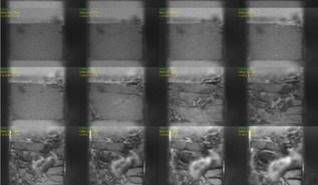Silicon carbide (SiC) is extremely hard, relatively light, corrosion resistant and capable of withstanding extreme temperatures. Enhancing relevant properties for different applications means developing different ceramics and testing them to check whether the outcome meets theoretical expectation.
Ultra-high-speed photography can assist with understanding the failure of SiC composites and ultimately help in developing better alloys.The Specialised Imaging SI-LUX640 laser illumination system provides up to 400W of lighting power at pulse frequencies up to 10MHz.
Silicon carbide (SiC) is widely used in abrasive and cutting processes – turning/milling, sand blasting and water-jet cutting, as a semiconductor and as a diamond simulant. The innate qualities of SiC make it an ideal candidate for body armour plates, these qualities can be degraded at elevated temperatures. For researchers seeking to improve the fracture toughness of SiC using techniques such as abnormal grain growth, understanding the characteristics of these altered materials and how they fail is crucial in developing the best solution.
Ultra-high-speed photography can provide invaluable insights into the failure dynamics of SiC composites, helping to identify the optimum material for use in the ceramic plates of bullet proof vests.
The Experiment
The split-Hopkinson pressure bar (SHPB) is an experimental technique to test the high strain rate response of materials. The results provide measurements allowing relative performances to be calculated and compared. However, this quantitative data doesn’t provide a full picture of how these samples behave during these microsecond timescale tests. If the numerical results are not as expected, then seeing what happened during the test may provide insight into the reasons.
The series of images captured by a Specialised Imaging SIM camera, shows a split-Hopkinson pressure bar set up, with the material specimen (10mm x 6mm) held between the incident bar on the right-hand side and the transmitting bar on the left hand side. A stress wave, travelling through the incident bar at the speed of sound of the bar material hits the sample, imparting energy and deforming it over a very short period of time. Consistent triggering of the camera was provided by a strain gauge picking up the passing of the stress wave on the incident bar upstream of the sample. The purpose of the experiment is to measure the material response to a sudden impact. The series of images spans a 16 μs time window from just prior to the shockwave arrival to long after sample failure. Cracks will propagate through SiC at around 16mm/μs and take approximately 625ns to cross the 10mm wide sample. Complete failure occurs between images 10 & 11, which provides an accurate trigger time for sample failure. This allows further tests to take advantage of the SIM camera nanosecond timing accuracy by concentrating more images into this shorter time window to observe where and how samples fail under different conditions. As with all ultra-high-speed photography, timing and lighting are crucial to achieving the best results.
Ultra-high-speed photography for materials research
As research pushes the boundaries of production methods, materials applications are increasingly demanding and understanding material failure is crucial, particularly where material failure may have significant health and safety or financial implications.
Specialised Imaging SIM cameras can be used to inform research in this area across a broad spectrum of materials, using different Hopkinson pressure bar configurations designed for compression, tension or torsion testing.




























